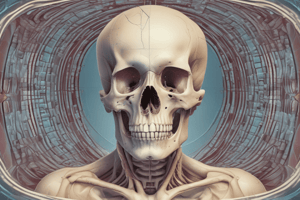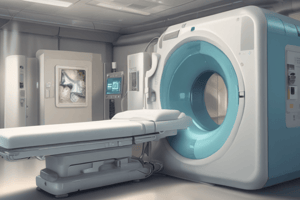Podcast
Questions and Answers
What mechanical motion is utilized in a third-generation X-ray system?
What mechanical motion is utilized in a third-generation X-ray system?
- Translational motion of the X-ray source only
- Rotational motion of both the X-ray source and detector array (correct)
- No mechanical motion
- Rotational motion of the detector array only
In a fourth-generation scanner, what remains stationary during the imaging process?
In a fourth-generation scanner, what remains stationary during the imaging process?
- The detector array (correct)
- The fan beam
- The X-ray source
- The patient
How long does it typically take to acquire projection data for an image in a third-generation system?
How long does it typically take to acquire projection data for an image in a third-generation system?
- Approximately 10 seconds
- Exactly 15 seconds
- As little as 1 second (correct)
- Around 5 seconds
What unique feature distinguishes fifth-generation scanners from third and fourth generation systems?
What unique feature distinguishes fifth-generation scanners from third and fourth generation systems?
What is the implication of having more independent detectors in a fourth-generation system?
What is the implication of having more independent detectors in a fourth-generation system?
Flashcards
Fourth-generation CT Scanner
Fourth-generation CT Scanner
A CT scanner where the X-ray source and fan beam rotate around the patient, while the detector array remains stationary.
Third-generation CT Scanner
Third-generation CT Scanner
A CT scanner where the X-ray source and detector rotate together.
Fifth-generation CT Scanner
Fifth-generation CT Scanner
A CT scanner where the X-ray source is an integral part of the system design. A high-energy electron beam is electronically swept along an anode, producing X-rays that rotate without moving parts.
Isocenter
Isocenter
Signup and view all the flashcards
Circular Detector Array
Circular Detector Array
Signup and view all the flashcards
Study Notes
X-Ray CT Scanner Generations
- First Generation: (Not described in the text).
- Second Generation: (Not described in the text).
- Third Generation:
- X-ray source and fan beam rotate around the isocenter, a fixed point.
- Curved detector array rotates alongside the source, containing the patient.
- Acquires projection data for a single image in about 1 second.
- Uses a larger number of detectors compared to second-generation systems
- Faster than second generation scanners
- Fourth Generation:
- X-ray source and fan beam rotate around the isocenter.
- Stationary detector array completely surrounds the patient.
- Uses a greater number of detectors (600-4800) than third-generation systems.
- Scan times are generally faster than third-generation systems (approximately 2 seconds).
- Number of views is equal to the number of detectors.
- Includes two configurations:
- Rotating source inside a fixed detector array.
- Rotating source outside of a nutating (rotating) detector array.
- Fifth Generation:
- X-ray source is integrated into system design, which is unique from other generations.
- Stationary detector array.
- High-energy electron beam is electronically swept in a semicircular path along a tungsten anode.
- X-rays are generated at the point of electron beam impact on the anode to create a collimated fan beam.
- Rotation around the patient is achieved without moving parts.
- Scan times for projection data acquisition are approximately [missing data].
Studying That Suits You
Use AI to generate personalized quizzes and flashcards to suit your learning preferences.
Description
This quiz covers the various generations of X-Ray CT scanners, highlighting the key features and advancements of each generation. Explore the differences between the third and fourth generations, including detector configurations and scan times. Test your knowledge of this critical imaging technology.




